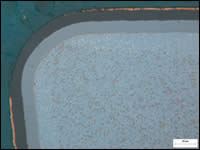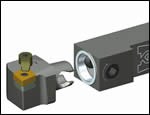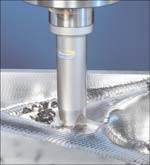The Incentive Effect
The Future of Machining - 2005 It's not just changes in machining challenges that matter. Changes in cost analysis and business arrangements are also driving the introduction of new tools.
Share


Hwacheon Machinery America, Inc.
Featured Content
View More
ECi Software Solutions, Inc.
Featured Content
View More.png;maxWidth=45)
DMG MORI - Cincinnati
Featured Content
View More




You get what you pay for. That time-worn statement is true in more ways than we may realize. You can't expect high value from an item purchased cheaply—that's what the statement usually means. But it also applies to the money we intend to spend. Whenever a group or an industry decides to pay for a particular thing, the decision creates an incentive that brings more of that very thing into existence. Whatever we are determined to pay for, that is what we're likely to get.
All of this may sound rather vague. But in a concrete way, the changing financial incentives in metalworking today represent a force that will drive the development of more capable, more targeted cutting tools during the next several years.
Prediction:
Financial incentives will drive cutting tool developments.
Bernard North makes this case. He is the vice president of research, development and engineering for cutting tool supplier Kennametal (Latrobe, Pennsylvania). While one might expect a VP of research to view the future in terms of the technologies being researched right now, that's not the way he sees things. All of the cutting tool technology we will need for much of the next decade probably has already been invented or identified, he says. The foreseeable future of cutting tools—that is, the tooling we will use in the next 5 or 10 years—will be determined not by what is newly discovered, but instead by what is brought out of the laboratory for commercial development. Economic incentives will shape and drive that progress.
The easiest example of an economic incentive affecting cutting tool development is the changing nature of the machining work that shops are asked to perform. Today, a larger share of metalcutting involves near-net-shape workpieces. Workpiece materials such as aluminum and magnesium are gaining favor as alternatives to iron and steel. Stainless steel, high temperature alloys and composites are also seeing more widespread use. Trends such as these obviously affect cutting tool development.
But set aside the changes in the machining work, and Mr. North sees other forces in play. The three changes described on the following page are also powerful where cutting tool development is concerned, even though these changes relate to nothing more than how money is viewed and awarded.
1. Different terms for tooling suppliers
Metalworking businesses that are large consumers of cutting tools are starting to use their clout to make tool suppliers accountable for productivity. The agreement often goes like this: The customer awards a particular vendor all of its tooling business, but in return that vendor agrees to improve the customer's efficiency by X percent every year.
Such an agreement can dramatically change the calculus of cutting tool implementation. In the past, there was a clear and obvious risk for the tool supplier in bringing a new tool to market. In cases where the existing offerings were adequate and customers knew how to use them well, a new product might not win acceptance. But now, the greater risk lies in not applying new technologies and new ideas. Unless it can come up with continually better products for key applications, the tooling supplier might risk falling short of its improvement goal.
2. Different compensation models for manufacturing professionals
Mr. North says he finds it more common for managers and engineers overseeing production operations to have an element of their compensation tied to the operations' performance. That is, they stand to get paid more if the processes produce better. Decision-makers who have this personal incentive tend to be more aggressive about embracing and implementing change. This attitude not only makes it more likely for new products to win acceptance, but it also makes it more likely that the advantages of new products will be fully exploited through the use of aggressive cutting conditions.
3. Different ways of looking at cost
A particular shop's choice between higher performance and lower performance tooling would seem to be driven by the technical merits of the two tools. In fact, that's often not the case. The choice may instead be determined by how the shop looks at costs. If the tooling budget is distinct and separate from other monies, then the lower purchase price of lower performance tooling may be compelling. However, if savings in other parts of the process are included in the analysis—that is, savings in machine time, labor, utilities, real estate, work-in-process inventory and so on—then the higher performance tooling may be more attractive, simply because of this change in perspective.
Many manufacturers are changing their decision-making process to take this broader view of tooling into account. Consumable tooling accounts for 3 to 4 percent of the total cost of machining operations, but because of its influence on cutting parameters, cycle times and the extent of operator involvement in the process, the choice of tooling helps to determine many other cost components that go into each piece. The broader view recognizes that tooling with a higher purchase price may deliver a lower cost per workpiece in the end.
This view has specific implications. High-performance tooling tends to be carbide, and carbide tooling tends to be coated. Mr. North's guess is that uncoated tools now account for just 10 percent of carbide tool sales overall. Both PVD and CVD coatings continue to be refined, and they leave ample room for development. Therefore, Mr. North expects the greater demand for high performance tools to result in significant advances in the effectiveness and variety of cutting tool coatings.
Targeted Solution
Those two areas of improvement—effectiveness and variety—are actually two sides of the same coin. When the demand increases in any particular area, it becomes cost effective to introduce a greater variety of specialized solutions within that niche. For example, the greater use of aluminum, magnesium and non-metallics as workpiece materials creates increased demand for PCD (polycrystalline diamond) tooling. This larger market for PCD means the markets for particular variations, such as different grain sizes, also become larger. Thus the appearance of a greater variety of choices in PCD tooling is easy to predict. And with more choices available, users will be able to find particular choices that work better in their own applications.
(By way of contrast, recall that the market for PCD was once so small that grain size was not a consideration. Essentially just one grain size was available.)
Improved machine tools provide another factor that will drive not only coated carbide and PCD development, but also the development of tool materials such as ceramics, cermets and PCBN (polycrystalline cubic boron nitride). Ditto for the machining of near-net-shape parts. While the improvements in machine performance will encourage shops to invest in tooling to take advantage of the improvement, near-net-shape parts favor the kind of cutting that the hard tool materials can do well. With an increase in speed and a decrease in cutting depth, tool wear resistance becomes more important, while tool toughness is less in demand.
Still Wet
At least one popular idea about the future of cutting tools has been overstated, Mr. North says. This is the notion that metalworking facilities will curtail the use of cutting fluids because of the environmental-related savings of machining dry.
In North America, manufacturers tend to assume that European facilities are already running without coolant to a large extent—making it almost inevitable that the same method of cutting will eventually arrive here. But actually, says Mr. North, European manufacturers still use a lot of coolant. Dry machining and minimum quantity lubrication might be more common there, but the extent of their acceptance is exaggerated. The extent of the interest in these processes is exaggerated, too, he says.
Some operations certainly have shifted away from coolant. Many shops are keenly interested in cutting dry. However, their motivations tend to be related to performance. A severely interrupted cut, for example, can often be performed better dry, because the severity of thermal shock is less. Shops reducing coolant use tend to be driven by these solidly technical motives, he says, and not by any value that they perceive in doing away with coolant as an end in itself.
Read Next
Upgrade Your Cutting Tool Mindset
A handful of timely observations may boost the productivity of your thinking about cutting tools.
Read MoreSetting Up the Building Blocks for a Digital Factory
Woodward Inc. spent over a year developing an API to connect machines to its digital factory. Caron Engineering’s MiConnect has cut most of this process while also granting the shop greater access to machine information.
Read MoreRegistration Now Open for the Precision Machining Technology Show (PMTS) 2025
The precision machining industry’s premier event returns to Cleveland, OH, April 1-3.
Read More













.png;maxWidth=150)





















.jpg;maxWidth=300;quality=90)













